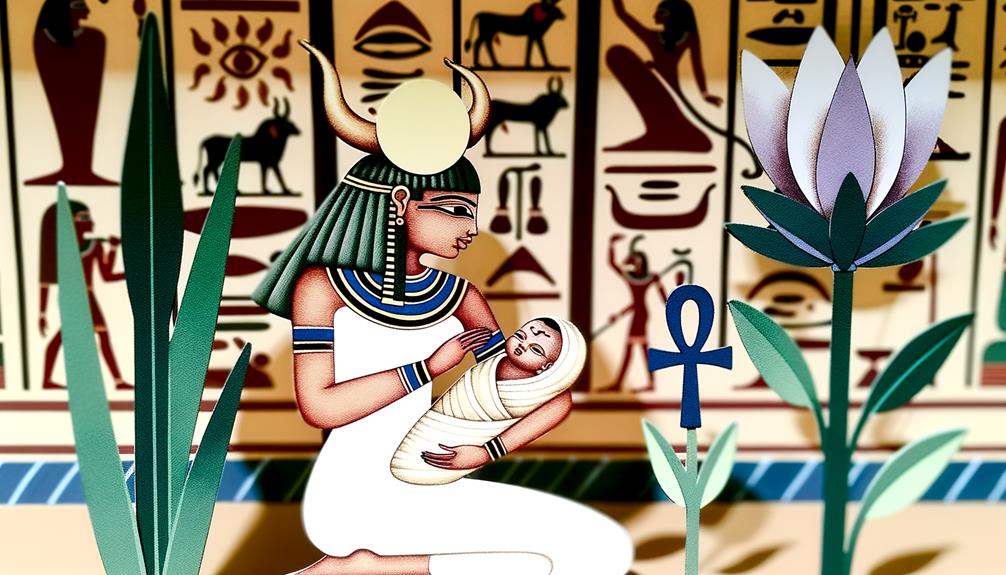The captivating world of ancient Egyptian mythology often captures my attention, particularly the tale of Hathor, the goddess of motherhood. She was adored as the divine cow, the source of life-giving milk. But Hathor wasn't just about motherhood, she symbolized happiness, music, and love. The Egyptians, through Hathor, painted a rich and powerful image of womanhood that is not often seen in other cultures.
You may ask, why should we bother about a goddess from an ancient civilization today? Good question. The myths of Hathor give us a unique glimpse into the societal values of ancient Egypt, where motherhood was held in high regard. But there is much more to Hathor's tale that we are yet to explore.
Hathor's Role in Ancient Egypt

Hathor, the ancient Egyptian goddess, held significant sway over the spiritual realm, bestowing her blessings on both the living and those who had passed on. She was much more than just a deity; she was a queen, a wife to the god Horus, and a mother to Pharaohs – a truly central figure in the lives of the ancient Egyptians.
In the rich tapestry of ancient Egypt's history, you'd often find Hathor represented as a woman with cow's ears or horns, with a sun disc sitting comfortably between them. Unlike other goddesses who were either feared or revered, Hathor was deeply loved for her gentle, caring nature. Her ties to the cosmos, the orbiting planets, and the cycle of life and death secured her a special spot in the hearts and minds of the ancients.
Hathor answered to many names, such as the mistress of life and the lady of stars. But her role in ancient Egypt was far from ordinary. She served as the conduit between the earthly and the heavenly, a cherished figure who guided souls both in life and in death. As Hathor, the goddess of motherhood, she personified ancient Egypt's deep connection to the cycles of life, love, and death.
Iconography of Goddess Hathor
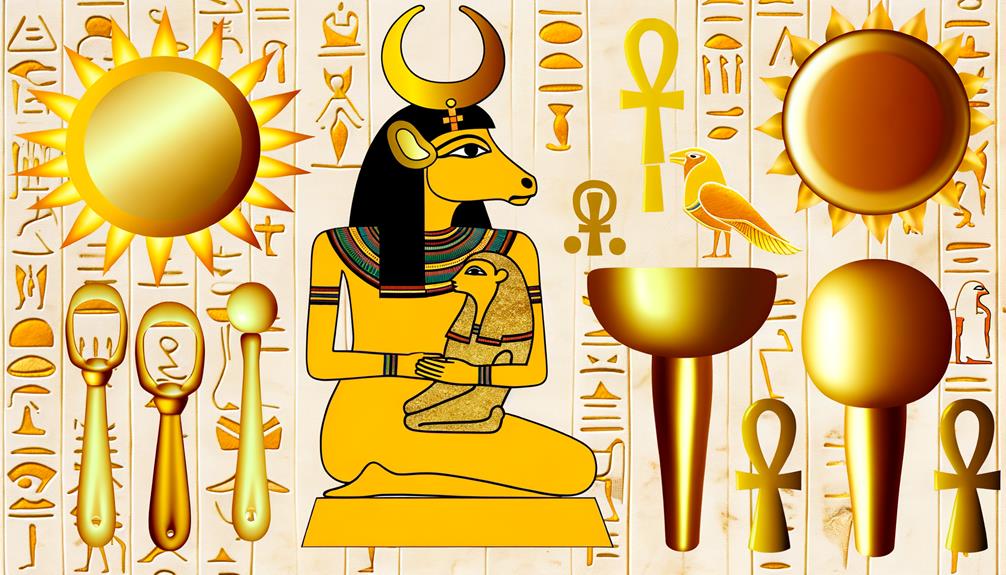
Let's chat about the vivid symbolism that surrounds Hathor, the ancient Egyptian goddess. Through her, tales of motherhood, love, and the cosmos are beautifully interwoven into the rich tapestry of Egyptian mythology. Hathor, revered as the goddess of love, is usually shown as a woman donning a cow-horn headdress with a sun disk nestled within, a sign of her nurturing and life-giving attributes. Another common depiction of Hathor is that of a cow, a powerful representation of motherhood, fertility, and nourishment.
In ancient Egypt, Hathor was held in the highest esteem. She was regarded as the mother of Pharaohs, embodying royal power and the divine feminine principle. Isis, another highly regarded goddess, often merges with Hathor in terms of iconography, blurring the boundaries between the two. This overlap further underlines their roles as nurturing and protective deities.
On a more joyous note, Hathor, also the goddess of joy, played a pivotal role in the Festival of Drunkenness. This was a celebration marked by joy and wild celebration. In this context, Hathor was often portrayed with a lioness' face, a symbol of her destructive power being tempered by joy and pleasure. This symbolized the dual nature of Hathor as a goddess who embodies both creation and destruction.
Significant Hathor Temples
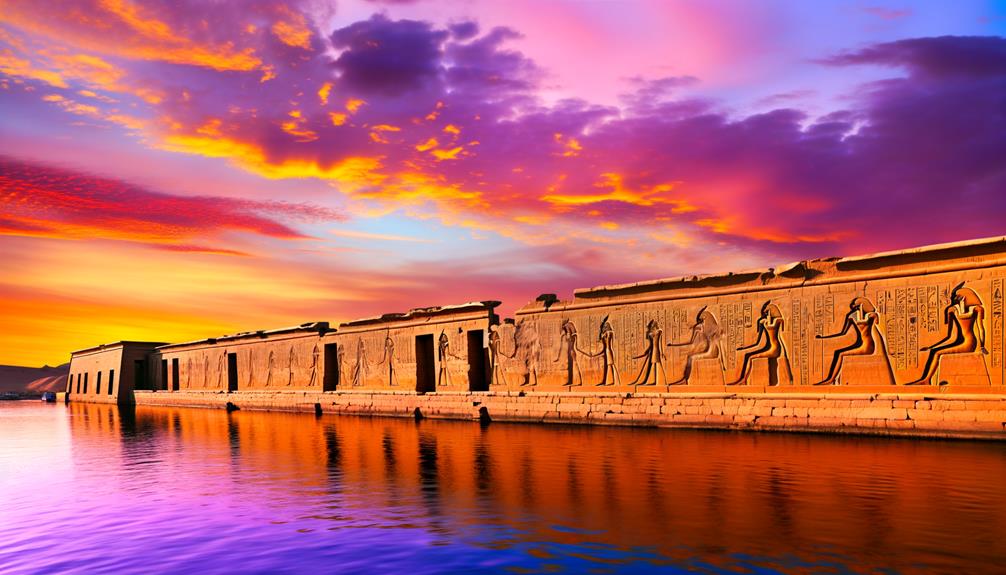
Let's talk about Hathor, an incredible figure in ancient Egyptian culture, and the remarkable temples built to honor her. These architectural wonders are scattered throughout Egypt and even beyond its borders, showing how far-reaching her influence was in those times.
Hathor was often seen as a cow goddess, a symbol of motherhood and fertility, and was deeply respected. There are many temples dedicated to her, but we'll focus on three key examples:
- At Dendera, there's a magnificent Temple of Hathor. This place is full of beautiful representations of the goddess. Here, Hathor was occasionally depicted in her celestial form, either as a woman with cow's ears or as a complete cow.
- The Temple of Philae, situated on Philae Island in the Nile, was another important site for Hathor worship. However, this temple wasn't just for Hathor but also for Isis, showing how their stories were closely linked.
- In Deir el-Medina, the craftsmen's village, there's another temple honoring Hathor, showing how much she was part of everyday life for the ancient Egyptians.
From Hatshepsut's mortuary temple to the turquoise mining camps in the Sinai desert, Hathor's impact was felt everywhere. This shows how central she was to the religion and society of ancient Egypt.
Festivals Celebrating Hathor
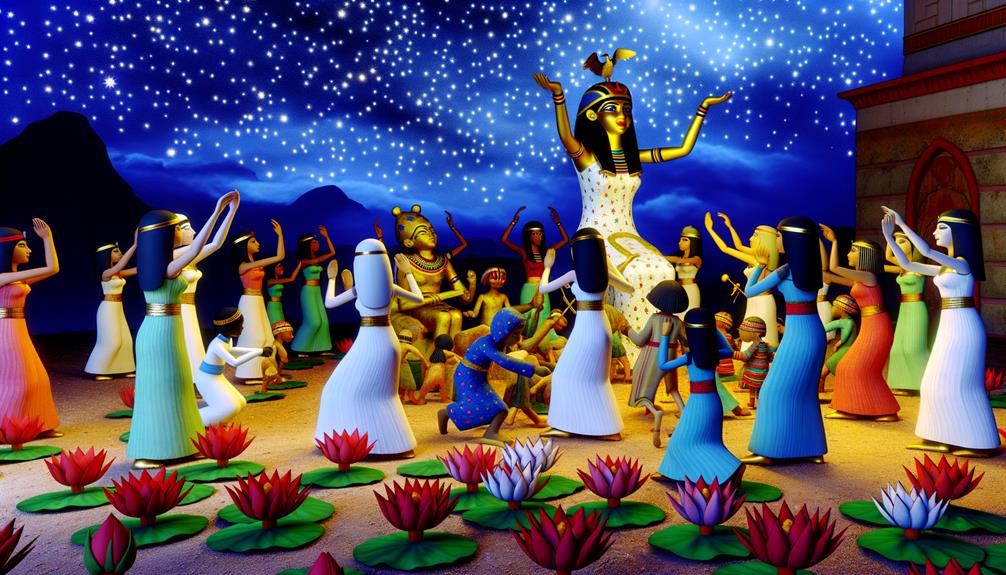
Hathor, a key figure in ancient Egyptian culture, was celebrated with a series of lively festivals. These events were not just for paying tribute to the goddess, but they also reflected the Egyptians' deep respect for life, love, and joy. This is particularly because Hathor was seen as the ultimate symbol of motherhood.
Now, let's discuss the main events that celebrated Hathor:
| Festival | What It's About | Main Highlights |
|---|---|---|
| Festival of Hathor | A tribute to Hathor at Dendera Temple Complex | Celebrated annually |
| Feast of Drunkenness | Saluting Hathor's joyful spirit | Involves music, dancing, and drinking |
| Turquoise Festival | Recognizing Hathor as the Mistress of Turquoise | Takes place in the Sinai desert |
| Nile Flooding Festival | Seeking Hathor's blessing for fertility | Features music, dancing, and offerings |
Hathor, often shown with the head or ears of a cow, represented abundance and motherhood. Her worship was closely linked with Horus, the sky god, forming a unique relationship between the two. These festivals weren't just simple celebrations; they were a profound expression of the Egyptians' thankfulness to Hathor for her blessings. By understanding these rituals, we can truly grasp the importance of Hathor's worship in ancient Egyptian culture.
Hathor's Influence on Funerary Practices
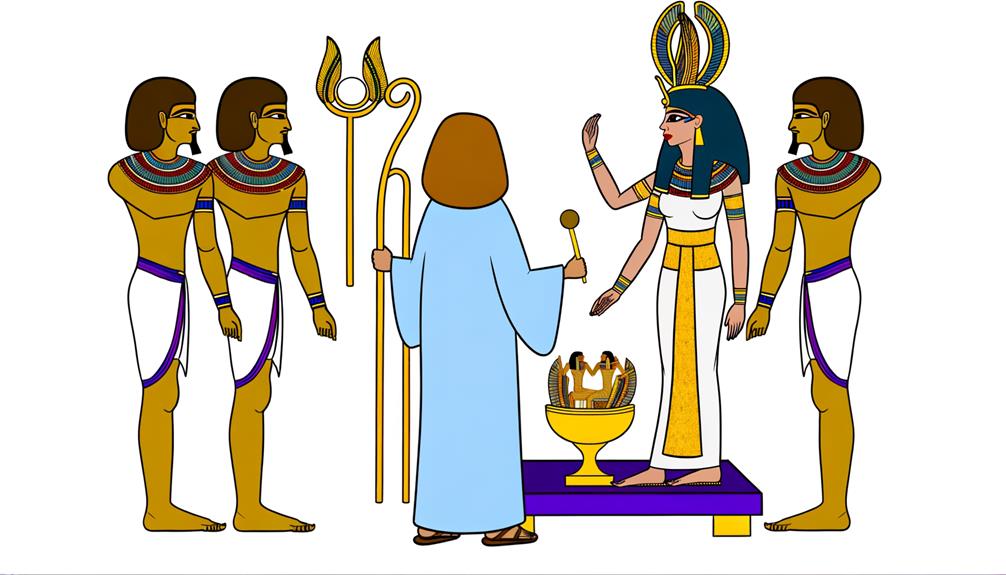
Let's talk about the end of life in ancient Egypt, where Hathor, the motherhood goddess, held a significant role. You see, Hathor wasn't only a symbol of joy and celebration, but also a guide for those transitioning to the afterlife.
Here's how Hathor's influence on funerary practices was evident:
First off, Hathor was known as the 'Lady of the West,' tying her to the necropolis of Thebes, known as the city of the dead. Secondly, in the Book of the Dead of Ani, she is portrayed as a cow, a warm welcome for those entering the afterlife. Lastly, her worship across different periods and towns – Old Kingdom, Middle Kingdom, New Kingdom, and even the Ptolemaic Period – shows her lasting impression.
But Hathor's influence went beyond just the mortal realm. She was a key player in the intricate world of Egyptian gods, often working alongside Osiris, the king of the underworld. From the Fourth Dynasty to the Pyramid Texts, myths about Hathor as the motherhood goddess were central to how ancient Egyptians understood death and the afterlife. So, the impact of Hathor was not just limited to life but extended beyond into the realm of the dead.
Frequently Asked Questions
Is Hathor the Goddess of Motherhood?
Absolutely, Hathor is the goddess of motherhood. The ancient Egyptians held her in high regard as a guardian figure, providing love, happiness, and motherly care to everyone. Not only that, but she's also linked with dance, music, and love. With her nurturing nature and vibrant associations, Hathor indeed embodies the spirit of motherhood in Egyptian mythology.
Who Is the Egyptian Mother Goddess Hathor?
I know a thing or two about mythology, especially when it comes to Hathor, the ancient Egyptian goddess. She holds a special place in the pantheon as she embodies love, joy, and significantly, motherhood. When you see a depiction of a cow or a woman with a sun disk, that's Hathor for you, signifying her crucial roles.
Who Did Hathor Have a Child With?
You know, I've been doing some reading about Hathor, the goddess from ancient Egypt. Did you know she had a kid with Horus-Behdety, who was her partner? Their child, a boy named Ihy, was all about music and happiness. It's interesting, because it's like he's a reflection of Hathor's own characteristics. It also really highlights how she was seen as a mother figure who took care of others.
Who Is the Egyptian Goddess of Childbirth?
You know, when you delve into the world of Egyptian mythology, it's pretty fascinating. Take Hathor, for instance. She's the goddess who's all about childbirth. She's got this nurturing vibe and is there for women when they're bringing a new life into the world. It's her thing, providing protection and assistance during the whole labor and birthing process. Cool, right?

